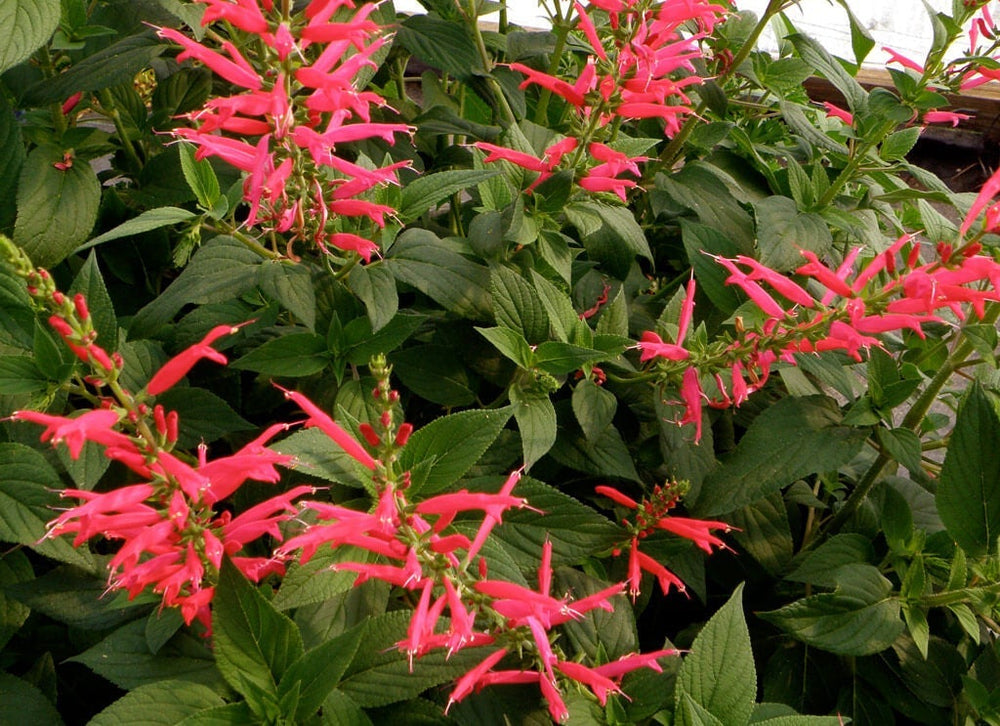Named for the uncanny pineapple scent of its foliage, pineapple sage is worth the wait. It is a seasonal treat that gives gardeners a sense of anticipation. A small plant set out in spring after the danger of frost has passed will grow into a branching plant 3 to 4 feet tall and nearly as wide by the time it blooms. It will then sprout spires of cardinal-red blooms in late summer and fall, just in time to refuel hummingbirds and butterflies for their fall migration. If you live in an area that does not freeze, blooms will continue all winter and sometimes all year.
Although cold hardy to about 20 degrees, pineapple sage is worth planting each spring in areas where it fails to return for another season. Try growing pineapple sage in sandy or otherwise sharply drained soil, which may allow it to tolerate colder temperatures by going dormant and sprouting new growth in spring. And start with strong young pineapple sage plants from Bonnie Plants®, the company that has been helping home gardeners find success for over a century.
Quick Guide to Growing Pineapple Sage
- Plant pineapple sage in spring once all chances of frost have passed.
- Space plants 24 to 36 inches apart. Grow them in a spot that gets abundant sunshine and has sandy well-drained soil with a pH of 6.0 to 8.0.
- Improve your native soil by mixing in several inches of aged compost or rich organic matter.
- Water regularly for the first few weeks after planting, then only water during a dry spell. Good drainage is essential during the growing season.
- Boost your harvest by feeding regularly with a continuous-release plant food.
- Harvest leaves and flowers once they are large enough to use, or leave them to attract pollinators.
Soil, Planting, and Care
Pineapple sage requires a place in the sunshine where the soil is well drained but moist and rich enough to support its rapid growth. Improve existing soil by mixing in a few inches of Miracle-Gro® Performance Organics®All Purpose In-Ground Soil with the top layer. Space plants 24 to 36 inches apart, and be sure not to plant them in front of other, smaller plants, as pineapple sage will grow large enough to block them out. In addition to planting in great soil, fertilize regularly throughout the growing season with Miracle-Gro® Performance Organics® Edibles Plant Nutrition—which feeds the soil as well as your plants—for best results.
Troubleshooting
Keep plants watered the first couple of weeks after planting. After that, you should only need to water during drought. Drainage is essential during the growing season, and even more important during the winter if you want plants to return in spring.
Harvest and Storage
Pineapple sage is primarily used fresh. Cuttings are easy to root if you want more plants, or would like to keep a plant indoors for replanting in spring.
Uses
Clip pineapple sage leaves to use in summer beverages such as herbal teas or cocktails, muddled with lime juice, or chopped on fruit salad including its namesake, pineapple. The red flowers are nice tossed into a green salad, too.


FAQs
Is pineapple sage used the same way as my other sage?
Pineapple sage and common sage are related. They are both salvias. Here the resemblance ends. They don't look alike or grow alike, and they certainly do not taste the same. Consequently, their uses are different. While common sage is well known for its contribution to sausage, poultry dishes, and herb blends, pineapple sage is appealing in fruit and sweet dishes. It has a pineapple-like scent. In addition, the autumn flowers give it an ornamental role in the garden.
Do butterflies like pineapple sage?
Butterflies like plants for nectar plants (for adults) and as host plants (for caterpillars). For nectar, the flowers of many herbs, including pineapple sage, bee balm, purple coneflower, lavender, thyme, feverfew, sage, chives, oregano, Mexican tarragon, mint, basil, and chamomile, provide the nourishment butterflies need. Host plants do require that you be willing to sacrifice as least some of your plants to the chewing of caterpillars, but it's worth it for butterfly larvae. Herbal host plants include parsley, dill, fennel, rue, and meadow rue (Thalictrum).
Why is my pineapple sage blooming this spring if it's supposed to bloom in fall?
Plants that are grown or overwintered in a greenhouse may bloom earlier than those settled into the cycle of the seasons. Just count yourself lucky to have such early blooms.




 Herbs
Herbs
 Vegetables
Vegetables
 Fruit
Fruit
 Flowers
Flowers
 Succulents
Succulents


